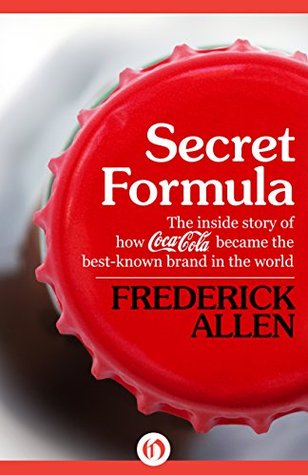More on this book
Kindle Notes & Highlights
Asa Griggs Candler, the eighth child, was the most exceptional of all. He was born in 1851 and showed an early interest in medicine.
Candler did not intend to stay in the cellar for long, like Pemberton, he had the heart of an entrepreneur.
In mid-July 1887, Lowndes and Venable concluded their deal with Pemberton by paying him $283.29 in cash for the physical assets of Coca-Cola: inventory, ingredients, advertising materials, and equipment,
had the goods carted to the basement of Jacobs’ Pharmacy,
He took $1,200 from her, and on December 14, 1887, he bought Lowndes’s two-thirds share of Coca-Cola.
Frank Robinson observed the latest twist in the fortunes of Coca-Cola and saw an opportunity.
During the winter of 1888, he pitched Coca-Cola to Asa Candler over and over again.
DOC Pemberton died on August 16, 1888.
They met in Asa Candler’s office at 47 Peachtree Street to pay tribute to Pemberton, and Candler spoke of “his lovable nature and many
virtues.”
Candler was now one of the most prosperous druggists in town.
Candler brought Frank Robinson into the business as if he were a member of the family.
The first order of business was to refine the formula for Coca-Cola.
Experimenting together, Robinson and Candler added glycerine to
the mix and found that it worked effectively as a preservative and smoothing agent.
So the extract of kola was cut to a minuscule amount
Candler and Robinson found themselves in the interesting position of preparing to market a product that contained very little of either ingredient in its trademark—an irony that would have profound legal implications (and shape an entire beverage industry) in the years to come.
Merchandise No. 1 was sugar, No. 2 caramel, No. 3 caffeine, No. 4 phosphoric acid, No. 5 the combination of coca and kola extracts, No. 6 glycerine, and No. 7X the super-secret blend of flavoring oils.
What really propelled Coca-Cola, in the end, was its ability to sell itself. In addition to advertising, Candler underwrote an aggressive sampling campaign for the drink that gave people a chance to try it for themselves for free.
At a nickel a drink, a druggist stood to pocket $6.40 if he could sell the second gallon.
But it worked.
In the summer of 1890, Candler’s second season, sales of Coca-Cola syrup more than quadrupled to 8,855 gallons.
Deliveries of Coca-Cola were made by Curtwright’s brother Bill on a dray pulled by a horse called “Ol’ Bird.”
For all the crudeness of Coca-Cola’s operations, however, sales continued to rise.
In the summer of 1891, Candler and Robinson sold 19,831 gallons of syrup, more than double the year before.
in the fall of 1891, he decided it was time to incorporate Coca-Cola, sell shares, and raise capital.
Asa Candler was stuck with the company. He would have to build Coca-Cola by himself.
there is no question that Pemberton’s son was an addict.
It was the nineteenth-century’s version of a direct-mail and street-corner sampling campaign, and it worked.
People tried Coca-Cola, liked it, and told their friends.
People believed that Candler must be putting something in his drink, and they thought that something was cocaine.
If Coca-Cola had one-thirtieth of a grain; it meant that heavy Coca-Cola drinkers might—might—feel some effects after several glasses.
Anyone could make an imitation. But no one could put the label “Coca-Cola” on an imitation so long as Candler owned the name.
So far as Candler could tell, Coca-Cola was now entirely free of cocaine,
He published a brochure saying Coca-Cola renewed “the vigor of the intellect.”
Coca-Cola’s double life, myth versus reality, was established.
By 1901, Coca-Cola’s annual sales had accelerated to nearly 500,000 gallons, and the company’s gross revenues were approaching the $1 million mark.
Coca-Cola was becoming a national product, available in every state of the union.
In preparing for trial, the Internal Revenue Office employed a chemist, Dr. Charles A. Crampton of Washington, D.C., to analyze a sample of Coca-Cola syrup, and after several tries he was unable to establish proof that cocaine was present.
Coca-Cola syrup contained one 400th of a grain of cocaine per ounce.
A man would explode before he could drink enough to affect him.”
landmark United States Supreme Court opinion written years later by Oliver Wendell Holmes.
the real injury to Candler and Coca-Cola came outside the courtroom, where a seismic shift in public opinion
about cocaine was just starting to shake the ground.
the sensational imaginings that were published on behalf of kola fed the flames of racial alarm, too.
It hardly mattered that Coca-Cola contained nothing but the merest trace of either drug named in its trademark.
Could he produce an extract of coca from which “every vestige” of cocaine was removed?
From Candler’s point of view, the removal of the last discernible trace of cocaine came just in time.
Citing the removal of the cocaine and arguing that the amount of alcohol in the syrup was inconsequential, he brought an appeal, and the War Department turned to Dr. Wiley to conduct tests and resolve the issue.
But Wiley had raised a new alarm, complaining that the caffeine in Coca-Cola was a health hazard.


